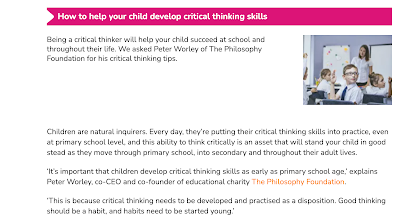- Have more High-school weeks at school. Often this is a one week initiative a year that we hold in Term 4. The Y9 learners have suggested perhaps having more of those. 2 in Term 3 and 2 in Term 4. Reason being, one of the main struggles for the Y9 learners was moving around the school for class.
- Create an opportunity for the Y9 learners to mentor the Y8 students. Meet with them couple times in Term 3 and in Term 4. First session is a "Get to know your mentees" and the rest of the sessions is when I implement some critical thinking tasks for the students to work on with each other.
Malo e Lelei, My name is Christine and I am a Year 7 and 8 teacher at Glen Taylor School.
Wednesday, July 31, 2024
Lightbulb Moment
Wednesday, July 10, 2024
Professional Readings
1. Teaching Critical Thinking - An evidence Based Guide
Critical thinking is about reasoning and asking questions, analysing and internalising. Critical thinking also allows students to become problem solvers through active investigation. It is also about “high order thinking processes” in order to make some informed decisions.
Games to promote critical thinking
Puzzles, mazes, mystery bag, brain teasers, rebus puzzles
HOW?
Encourage agree & disagree
Asking why questions
Talk about implications / solutions
Reflections
- This reading was a reminder of why teaching Critical Thinking is important for the students learning. The benefits of critical thinking goes beyond the classroom and can be applied to any experience in education.
- As teachers, when Teaching Critical Thinking Skills, it's important to slow down the pace. Pose a question of the day as something to stimulate thinking. Create a response box that students can slot their responses in throughout the day. Debates is also a great class activity for students to partake in. Deciding whether they're for or against a proposition is effective.
2. 5 Critical Thinking Skills Kids need to Learn
- Children are naturally curious to find out how things work, to make sense of the world around them - they use their critical thinking skills.
- Children who have been taught critical thinking skills, have higher IQs and do better in language comprehension and problem-solving.
Encourage students to ask ‘why’. Ask do you agree/disagree and give reasons. Ask for clarification and if they can give you an example.
Talk about implications. When reading a story, stop in the middle and ask what do you think will happen next. Why or what would you do.
3. How to help your child develop Critical Thinking Skills
- Children who have been taught critical thinking skills, have higher IQs and do better in language comprehension and problem-solving.
- Encourage students to ask ‘why’. Ask do you agree/disagree and give reasons. Ask for clarification and if they can give you an example.
- Talk about implications. When reading a story, stop in the middle and ask what do you think will happen next. Why or what would you do.



